Tuesday, February 28, 2006
"Priceless" Documents...........!
THE WORLD OF THE SCROLLS
--------------------------------------------------------------------------------
In 1947, young Bedouin shepherds, searching for a stray goat in the Judean Desert, entered a long-untouched cave and found jars filled with ancient scrolls. That initial discovery by the Bedouins yielded seven scrolls and began a search that lasted nearly a decade and eventually produced thousands of scroll fragments from eleven caves. During those same years, archaeologists searching for a habitation close to the caves that might help identify the people who deposited the scrolls, excavated the Qumran ruin, a complex of structures located on a barren terrace between the cliffs where the caves are found and the Dead Sea. Within a fairly short time after their discovery, historical, paleographic, and linguistic evidence, as well as carbon-14 dating, established that the scrolls and the Qumran ruin dated from the third century B.C.E. to 68 C.E. They were indeed ancient! Coming from the late Second Temple Period, a time when Jesus of Nazareth lived, they are older than any other surviving manuscripts of the Hebrew Scriptures by almost one thousand years.
Since their discovery nearly half a century ago, the scrolls and the identity of the nearby settlement have been the object of great scholarly and public interest, as well as heated debate and controversy. Why were the scrolls hidden in the caves? Who placed them there? Who lived in Qumran? Were its inhabitants responsible for the scrolls and their presence in the caves? Of what significance are the scrolls to Judaism and Christianity............?
-from -
Scrolls From The Dead Sea: The Ancient Library of Qumran and Modern Scholarship (Library Of Congress Exhibition)
---------------------------------------------------
Pretty intriguing, wouldn't you agree? I get a "vivid visual picture" in my "mind's eye". Straight from an Indiana Jones or Allan Quatermain adventure. Now, I would never compare myself to "Indy" or "Quatermain", but I did some exploring the other day and found some "buried parchments" that are of historical value. Obviously not in the same category as the Dead Sea Scrolls, but nonetheless outstanding records. See what you think. All the re-produced "parchments" should be viewed full-screen. Left-click on picture, then left-click on expander-button.
-----------------------------------------------------
*********** HISTORICAL DOCUMENTS ***********
PRATT & WHITNEY DOUBLE WASP "B" SERIES ENGINES
(With Two-Stage Supercharger)
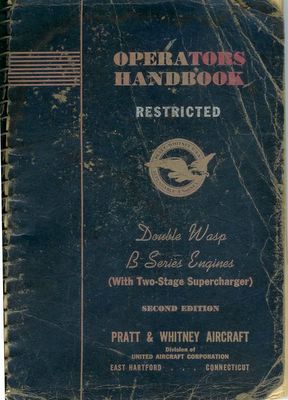
P&W "Double Wasp" Operators Handbook cover.
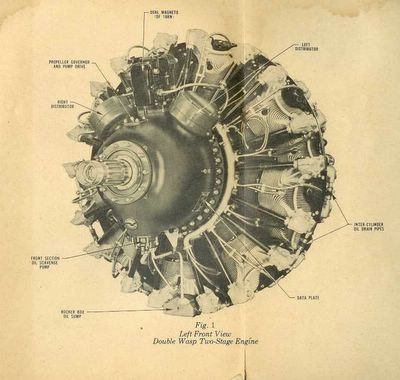
Front Left View


Left Rear View

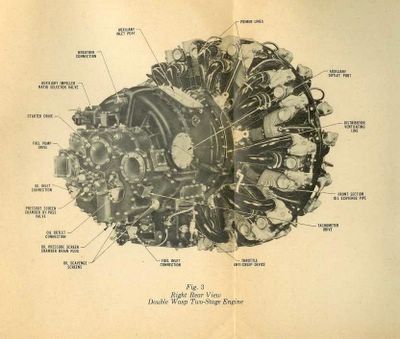
Right Rear View


Front Cam Compartment


Main & Aux. Blower


Reduction Gearing

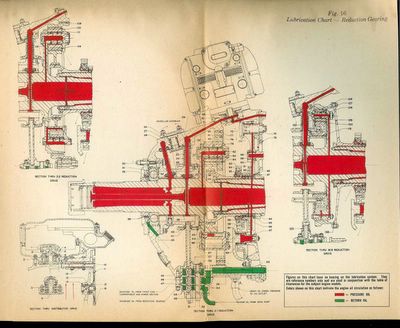
Lubrication Chart


Main Crank Case

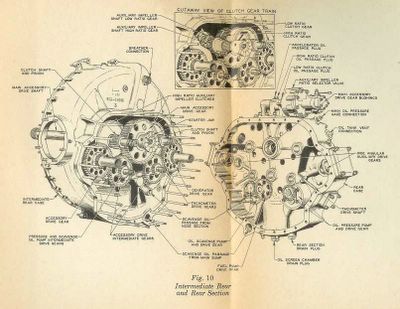
Rear Section and Clutch Gear Train

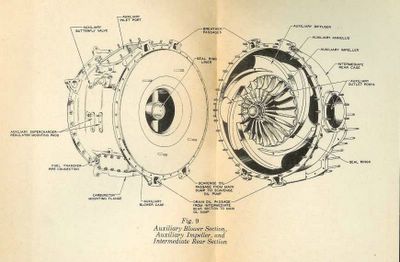
Auxiliary Blower


Main Crankcase

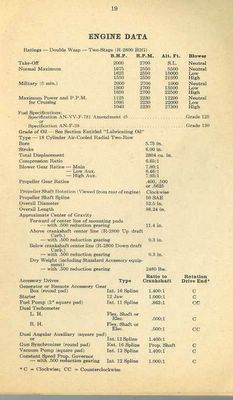
Engine Data

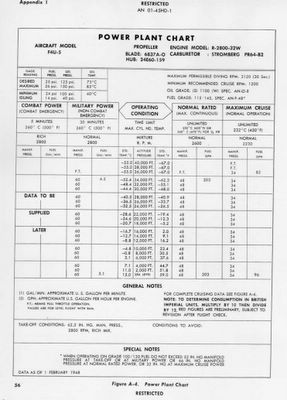
F4U-5 "Corsair" Power Plant Chart
---------------------------------------------------------------------
So, there you have it. Not quite in the same league as "Biblical Documents", but nonetheless very intriguing to an "Aviation Aficionado" like myself!
"Cheers!"

The real "Dead Sea Scrolls", truly "priceless" documents.........
--------------------------------------------------------------------------------
In 1947, young Bedouin shepherds, searching for a stray goat in the Judean Desert, entered a long-untouched cave and found jars filled with ancient scrolls. That initial discovery by the Bedouins yielded seven scrolls and began a search that lasted nearly a decade and eventually produced thousands of scroll fragments from eleven caves. During those same years, archaeologists searching for a habitation close to the caves that might help identify the people who deposited the scrolls, excavated the Qumran ruin, a complex of structures located on a barren terrace between the cliffs where the caves are found and the Dead Sea. Within a fairly short time after their discovery, historical, paleographic, and linguistic evidence, as well as carbon-14 dating, established that the scrolls and the Qumran ruin dated from the third century B.C.E. to 68 C.E. They were indeed ancient! Coming from the late Second Temple Period, a time when Jesus of Nazareth lived, they are older than any other surviving manuscripts of the Hebrew Scriptures by almost one thousand years.
Since their discovery nearly half a century ago, the scrolls and the identity of the nearby settlement have been the object of great scholarly and public interest, as well as heated debate and controversy. Why were the scrolls hidden in the caves? Who placed them there? Who lived in Qumran? Were its inhabitants responsible for the scrolls and their presence in the caves? Of what significance are the scrolls to Judaism and Christianity............?
-from -
Scrolls From The Dead Sea: The Ancient Library of Qumran and Modern Scholarship (Library Of Congress Exhibition)
---------------------------------------------------
Pretty intriguing, wouldn't you agree? I get a "vivid visual picture" in my "mind's eye". Straight from an Indiana Jones or Allan Quatermain adventure. Now, I would never compare myself to "Indy" or "Quatermain", but I did some exploring the other day and found some "buried parchments" that are of historical value. Obviously not in the same category as the Dead Sea Scrolls, but nonetheless outstanding records. See what you think. All the re-produced "parchments" should be viewed full-screen. Left-click on picture, then left-click on expander-button.
-----------------------------------------------------
*********** HISTORICAL DOCUMENTS ***********
PRATT & WHITNEY DOUBLE WASP "B" SERIES ENGINES
(With Two-Stage Supercharger)

P&W "Double Wasp" Operators Handbook cover.


Front Left View


Left Rear View


Right Rear View


Front Cam Compartment


Main & Aux. Blower


Reduction Gearing


Lubrication Chart


Main Crank Case


Rear Section and Clutch Gear Train


Auxiliary Blower


Main Crankcase


Engine Data


F4U-5 "Corsair" Power Plant Chart

---------------------------------------------------------------------
So, there you have it. Not quite in the same league as "Biblical Documents", but nonetheless very intriguing to an "Aviation Aficionado" like myself!
"Cheers!"

The real "Dead Sea Scrolls", truly "priceless" documents.........

Steve's Video Of The Day: The "Crazy Boys!"......
Just a bunch of "good ole boys" testing themselves and their machines, and enjoying themselves in the process. Show me a pilot that always flies "straight and level", and I will "sell you a bridge".
VIDEO - The "Crazy Boys!"......
VIDEO - The "Crazy Boys!"......
Monday, February 27, 2006
Steve's Video Of The Day: Let's "Build An Airbus".......
"Top 'o the mornin' to ya', lads and lassies! Got a few minutes? Smashing! Follow me, let's go build an Airbus!"
VIDEO - Let's "Build An Airbus".......
VIDEO - Let's "Build An Airbus".......
Sunday, February 26, 2006
"Fly-In" Fuel Filters.......
Friday morning I was asked if I could do a quick trip to Gunisao Lake to deliver some fuel filters to my friends Rick and Brian Eyolfson. They own Bennett Lake Lodge And Outcamps and are "up" the winter road making a trail to Bennett and Gunisao Lakes. They are using snowmobiles and a large track machine, and are hauling all their supplies and fuel in, and also doing the same for the Gunisao Lodge owners, so when spring comes, they are set to operate. While enroute to Gunisao on the "trail-breaking" trip, they had fuel problems 20 miles from Gunisao. It was quickly determined that it was a fuel filter problem. Rick and Brian's Dad, Wally, picked up some new fuel filters, and he would accompany me to deliver them.
We needed a 4X4 to get down the access road to the airport, as it had drifted in. The aircraft we used was C-185 C-GULA. This aircraft is owned by Rick and Brian, and is the aircraft I used for last year's Duck Mountain's Survey. By the time we prepped the airplane, warmed it up, and loaded our gear, it was just about 2 o'clock. We would just have enough time to go to Gunisao and back, as it is about 175 miles each way, and we would have a stiff head-wind north-bound. Wally and I "crammed" ourselves into the front seats, and with "one last swig" from his "mickey of pre-mixed", Wally was ready, and I opened the throttle. The Kehler fixed-penetration wheel-skis handled the small drifts on the runway, and we were airborne!
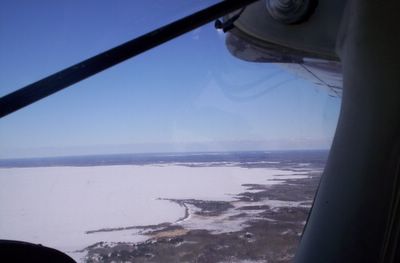
"Unforgiving" Lake Winnipeg!

A "frozen expanse".

The Bradbury River, just north of Bloodvein Indian Reserve "sleeps".

You can see where the "winter road" crosses the Bradbury.
North, we flew, crossing the Pigeon, Berens, and Etomami Rivers. The animal tracks around the Etomami River were stunning. There was an abundance of moose tracks and ski-doo tracks following the moose tracks. As we neared the Poplar River, we started to see more caribou tracks. We crossed Weaver Lake, and about 20 miles north we saw some caribou. There were 12 on a small lake, but there were tracks everywhere. We continued, and finally Gunisao was in sight. I flew over to survey where I would land on the lake, and picked a nice spot east of the lodge. It looked basically drift-free. I was hoping there wasn't any slush. Wally had had another "swig" of liquid courage about 15 minutes previous, and seemed to be thoroughly enjoying the trip and the scenery. I approached the lake, 30* of flap, power-on, and "feathered" the airplane onto the lake. The landing was so soft, you wouldn't have even "spilled your beer"! I kept the power on and made a circle, so I could stop on a packed trail, and look for slush. Actually, the conditions were better than I thought, with granular "sugar" snow, and no slush where we landed. We shut down and were greeted by Rick and Brian.
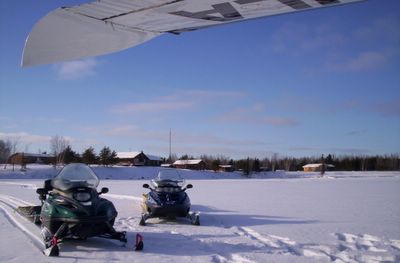
Gunisao Lodge in the background, and Rick's and Brian's "mounts".

Brian fuelling ULA for the trip south.
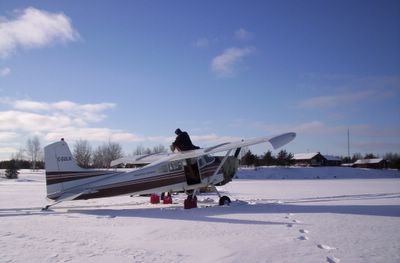
A "Manitoba winter".
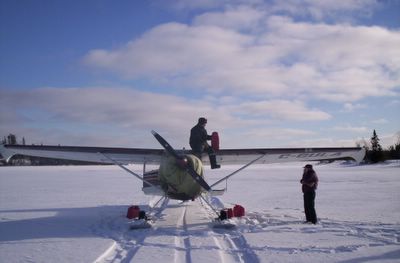


Fuelling complete!
Due to the lateness of the day, we didn't spend any extra time at the camp, though we would have liked to. We gave the boys the filters, bid them "adieu", and we were southbound! We flew low to where we had seen the caribou earlier, and circled the lake. The caribou looked very healthy, and headed into the bush. We now had a tail-wind, and we "whistled" south!
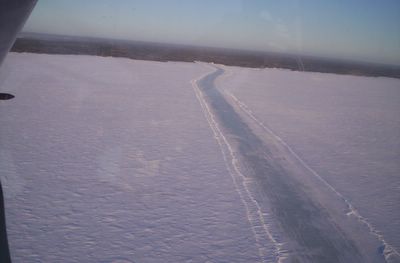
The "winter road crossing" on lake Winnipeg from Pine Dock to Bloodvein. It looks in decent shape.
Well, we landed, secured the airplane, and it was just before dark. Wally was happy that his boys received their parts, and could continue their hauling. Therefore, he offered to buy me a beer, which I accepted. We headed for the bar, but like the old saying goes, "One is too many, and 12 is never enough!", but we made it home safe and sound. Till next time, "Adios!"
We needed a 4X4 to get down the access road to the airport, as it had drifted in. The aircraft we used was C-185 C-GULA. This aircraft is owned by Rick and Brian, and is the aircraft I used for last year's Duck Mountain's Survey. By the time we prepped the airplane, warmed it up, and loaded our gear, it was just about 2 o'clock. We would just have enough time to go to Gunisao and back, as it is about 175 miles each way, and we would have a stiff head-wind north-bound. Wally and I "crammed" ourselves into the front seats, and with "one last swig" from his "mickey of pre-mixed", Wally was ready, and I opened the throttle. The Kehler fixed-penetration wheel-skis handled the small drifts on the runway, and we were airborne!

"Unforgiving" Lake Winnipeg!


A "frozen expanse".


The Bradbury River, just north of Bloodvein Indian Reserve "sleeps".


You can see where the "winter road" crosses the Bradbury.

North, we flew, crossing the Pigeon, Berens, and Etomami Rivers. The animal tracks around the Etomami River were stunning. There was an abundance of moose tracks and ski-doo tracks following the moose tracks. As we neared the Poplar River, we started to see more caribou tracks. We crossed Weaver Lake, and about 20 miles north we saw some caribou. There were 12 on a small lake, but there were tracks everywhere. We continued, and finally Gunisao was in sight. I flew over to survey where I would land on the lake, and picked a nice spot east of the lodge. It looked basically drift-free. I was hoping there wasn't any slush. Wally had had another "swig" of liquid courage about 15 minutes previous, and seemed to be thoroughly enjoying the trip and the scenery. I approached the lake, 30* of flap, power-on, and "feathered" the airplane onto the lake. The landing was so soft, you wouldn't have even "spilled your beer"! I kept the power on and made a circle, so I could stop on a packed trail, and look for slush. Actually, the conditions were better than I thought, with granular "sugar" snow, and no slush where we landed. We shut down and were greeted by Rick and Brian.

Gunisao Lodge in the background, and Rick's and Brian's "mounts".


Brian fuelling ULA for the trip south.


A "Manitoba winter".




Fuelling complete!

Due to the lateness of the day, we didn't spend any extra time at the camp, though we would have liked to. We gave the boys the filters, bid them "adieu", and we were southbound! We flew low to where we had seen the caribou earlier, and circled the lake. The caribou looked very healthy, and headed into the bush. We now had a tail-wind, and we "whistled" south!

The "winter road crossing" on lake Winnipeg from Pine Dock to Bloodvein. It looks in decent shape.

Well, we landed, secured the airplane, and it was just before dark. Wally was happy that his boys received their parts, and could continue their hauling. Therefore, he offered to buy me a beer, which I accepted. We headed for the bar, but like the old saying goes, "One is too many, and 12 is never enough!", but we made it home safe and sound. Till next time, "Adios!"

















